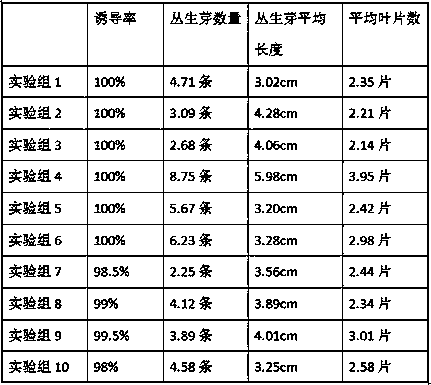In-vitro rapid propagation method for North American magnolia
An in vitro and magnolia technology, applied in the field of plant breeding, can solve the problems of low survival rate and maintenance of unfavorable traits, etc., and achieve the effect of fast growth
- Summary
- Abstract
- Description
- Claims
- Application Information
AI Technical Summary
Problems solved by technology
Method used
Image
Examples
Embodiment 1
[0029] Embodiment 1 A kind of in vitro rapid propagation method of Magnolia magnolia
[0030] 1. Material preparation
[0031] The experiment was carried out in the Tissue Culture Center of Weifang Vocational College from 2010 to 2012, and the experimental material was 'Sticata' magnolia ( Magnolia 'Stricta' ).
[0032] 2. Selection of explants
[0033] Select the 'Sticata' Magnolia individual plant with vigorous growth, no damage by diseases and insect pests, and good performance in the outdoor; cut the explants with scissors, the temperature is 15 ℃ when cutting the explants, and the humidity is 46%;
[0034] The cut explants are: stem section with axillary buds, requirements: the stem section is semi-lignified, with 1 full axillary bud, and the length of the stem section is 2.4cm.
[0035] 3. Disinfection of explants
[0036] Place the explants in a triangular flask, add detergent and water, shake continuously, and wash for 14 minutes; then rinse with clean water for 3 ...
Embodiment 2
[0055] The influence of embodiment 2 different parts explants and sterilization time on survival rate
[0056] Adopt the method of embodiment 1 to breed North American 'Sticata' Magnolia, only change the explant part clipped in step 2 and the mercury chloride disinfection time in step 3, carry out embodiment 2-5; Specific changes are shown in Table 1 ;
[0057] Table 1 Clipped explants and mercuric chloride disinfection time
[0058]
[0059] See Table 2 for the explant survival rate cultivated by embodiment 1-5;
[0060] Table 2 The explant survival rate of embodiment 1-5 propagation cultivation
[0061]
[0062] As can be seen from Table 2, the explant disinfection pollution rate of embodiment 3 breeding is the lowest, and the survival rate is the highest, which is a preferred embodiment; that is, the explant position is preferably a stem section with axillary buds, and the length of the stem section is preferably 2.8cm. The number is preferably 2, and the mercury c...
Embodiment 6
[0063] Example 6 Induction test of different mediums on clustered buds of Magnolia magnolia
[0064] Adopt the method of embodiment 1 to carry out tissue culture, only change the differentiation medium in step 6 differentiation culture, carry out experiment, totally 10 experimental groups, the specific differentiation medium of each experimental group is as follows:
[0065] Experimental group 1: MS medium + 6-BA 0.4 mg / L + IBA 0.08 mg / L + sucrose 25 g / L + agar 9 g / L;
[0066] Experimental group 2: MS medium + 6-BA 0.3 mg / L + IBA 0.06 mg / L + sucrose 28 g / L + agar 8g / L;
[0067] Experimental group 3: MS medium + 6-BA 0.2 mg / L + IBA 0.04 mg / L + sucrose 25 g / L + agar 9 g / L;
[0068] Experimental group 4: MS medium + 6-BA 0.1 mg / L + IBA 0.02 mg / L + sucrose 26 g / L + agar 9 g / L;
[0069] Experimental group 5: MS medium + 6-BA 0.05 mg / L + IBA 0.08 mg / L + sucrose 25 g / L + agar 9 g / L;
[0070] Experimental group 6: MS medium + 6-BA 0.3 mg / L + NAA 0.06 mg / L + sucrose 25 g / L + agar 9 ...
PUM
 Login to View More
Login to View More Abstract
Description
Claims
Application Information
 Login to View More
Login to View More - R&D
- Intellectual Property
- Life Sciences
- Materials
- Tech Scout
- Unparalleled Data Quality
- Higher Quality Content
- 60% Fewer Hallucinations
Browse by: Latest US Patents, China's latest patents, Technical Efficacy Thesaurus, Application Domain, Technology Topic, Popular Technical Reports.
© 2025 PatSnap. All rights reserved.Legal|Privacy policy|Modern Slavery Act Transparency Statement|Sitemap|About US| Contact US: help@patsnap.com



